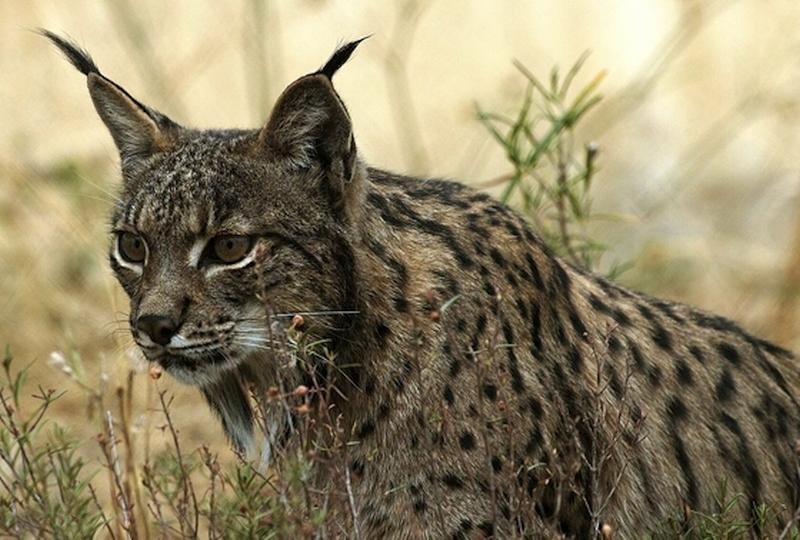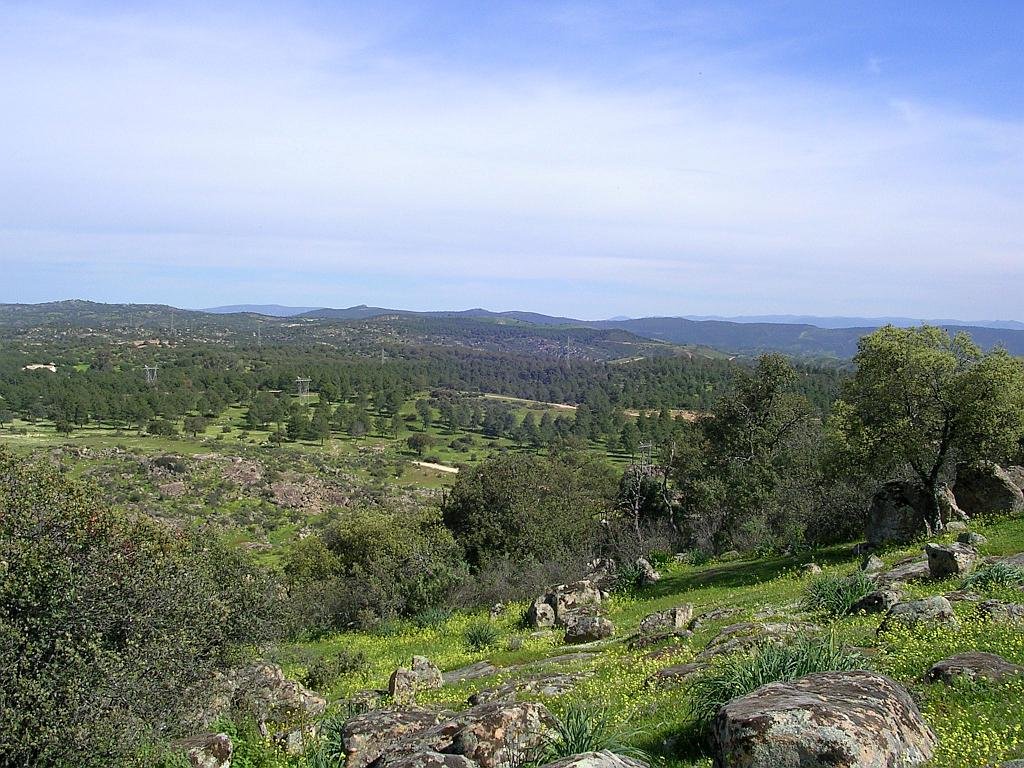- Region: Andalucia
- Province: Jaén
- Declared a Natural Park: 1989
- Park surface area: 73.976 hectares
Points of interest
The Sierra de Andujar natural park is located in the central part of the Sierra Morena and is a semi-mountainous area with peaks ranging between 500 to 1290m, the highest peak being Burcio del Pino.
The densely wooded areas maintain their natural Mediterranean vegetation. The northern edge borders with Ciudad Real, a province of Castilla la Mancha. To the west is the Cardeña y Montoro natural park, the two parks only being separated by the river Yeguas. There are two reservoirs in the eastern side of the park, Embalse del Jándula and Embalse El Encinarejo.
There are also two game hunting reserves that connect with the parks borders.
The park holds three threatened species, Iberian lynx, Imperial eagle and Black vulture. (The Iberian wolf appears to have gone from this area now)
The area has also become famous as a starlight destination. The Starlight Foundation is a non-profit organization that was founded in 2009 to promote the protection of the night sky and the development of “astrotourism” and there is an ever growing list of starlight destinations in Spain to visit.
Flora
Holm (Quercus ilex) Gall (Q. faginea) and Cork oaks (Q. suber) with a natural thicket of Strawberry trees (Arbutus unedo), Lentisc (Pistacia lentiscus), Myrtle (Myrtus communis), Wild olives (Olea europaea subsp. oleaster), Kermes oak (Quercus coccifera), Thyme, Rosemary (Rosmarinus officinalis) and Calamint (Calamintha nepeta) form the native undisturbed Mediterranean tapestry. The Sierra Quintana has an excellent area of Atlantic oak woodland (Quercus atlantica).
Willows, Poplars, Oleanders and Alder trees are part of the selection seen on the rivers banks. Stone pines (Pinus pinea) also form important woodlands here and edible pine kernels are still harvested in this area.
There are several unusual plants in the park to note, such as Frangula alnus subsp. baetica, Digitalis purpurea subsp. heywoodii, Coincya longirostra and Jasione crispa subsp. Mariana.
Find a place to stay in the Sierra de Andújar
Nestled in the heart of Sierra de Andújar Natural Park, local accommodations offer a quiet escape with direct access to nature. Options range from rustic cottages to eco-friendly lodges, often set among olive groves or forested hills. These stays blend comfort with authenticity, featuring wood-burning stoves, local breakfasts, and terraces perfect for stargazing or wildlife watching. Whether you’re here to hike, unwind, or spot the elusive Iberian lynx, each place provides a peaceful base to explore one of Andalusia’s most unspoiled landscapes.
When visiting the Sierra de Andújar I have always stayed at the Hotel Oleum. Its a great place to use as a base to discover the area.
Fauna
This is one of the few remaining habitats where the endangered Spanish lynx roams.

If you are really interested in seeing Iberian lynx then get in touch with Mick Richardson from Granada Wildlife.
Important species for game hunting in the area are the Wild boar, Mouflon, Red, Fallow and Roe deer. Mongoose, Remember that hunting is strictly controlled in this area and is a part of the conservation strategy for the natural park
Wild cat and Fox are amongst the nocturnal mammals with elusive Otters on the river banks.
At the high rocky crags to the north of the park are Griffon and Egyptian vultures, Golden and Imperial eagle plus Red-billed chough. There are Azure-winged magpies and near to the water are Golden orioles, Nightingale, Purple and Grey herons.
Also in the area
- The town of Andújar, south of the park, has a Roman bridge of 15 arches spanning the Guadalquivir river.
- There are wonderful views from the 13thC sanctuary built on a towering crag, La Virgen de la Cabeza. There is a pilgrimage which makes its way to the sanctuary from Andújar on the last Sunday of April each year. “La Romería de la Virgen de la Cabeza” is the largest festival of Andújar with around half a million participants.
Information/Visitors Centers
The Viñas de Peñallana visitor centre is at the entrance to the Nature Park is on the J5010 Andújar-Santuario Virgen de la Cabeza road.
- It offers visitors an introduction to the different types of landscape to be found in the area and to the numerous animal species they support.
- The Iberian lynx is perhaps the Park’s most emblematic species. Visitors can follow its tracks to discover its habitat and learn about its behaviour and about the problems which have made it the most threatened species of feline on Earth.
- The centre also provides information about the lifestyles and history of the Park’s human inhabitants, explaining how their respectful exploitation of the area’s natural resources has contributed towards the conservation of important environments in places like the Sierras de Andújar.
Frequently Asked Questions about Sierra de Andújar Natural Park
The Sierra de Andújar Natural Park is a semi-mountainous protected area in the province of Jaén, Andalusia, Spain. Located in the heart of the Sierra Morena, it was declared a Natural Park in 1989 and spans 73,976 hectares. Elevations range from 500 to 1,290 meters, with Burcio del Pino being the highest peak. The park is known for its dense Mediterranean forest, proximity to Ciudad Real and Cardeña y Montoro Natural Park, and two major reservoirs—Embalse del Jándula and Embalse El Encinarejo.
The park features classic Mediterranean vegetation. Tree species include Holm oak (Quercus ilex), Gall oak (Q. faginea), and Cork oak (Q. suber), along with undergrowth like Strawberry tree (Arbutus unedo), Lentisc, Myrtle, Wild olives, Kermes oak, Thyme, Rosemary, and Calamint. Sierra Quintana preserves rare Atlantic oak woodland (Quercus atlantica). Riverbanks host Willows, Poplars, Oleanders, and Alders. Stone pine groves produce edible pine kernels. Rare plants include Frangula alnus subsp. baetica, Digitalis purpurea subsp. heywoodii, Coincya longirostra, and Jasione crispa subsp. mariana.
The park is one of the last strongholds of the Iberian lynx, one of the world’s most endangered felines. Other threatened species include the Spanish Imperial eagle and Black vulture. While the Iberian wolf no longer inhabits the park, it supports game species like Wild boar, Mouflon, Red, Fallow, and Roe deer, with hunting regulated as part of conservation strategy. Nocturnal mammals include Wild cat, Fox, and Otter. Birds include Griffon and Egyptian vultures, Golden and Imperial eagles, Red-billed choughs, Azure-winged magpies, Nightingales, and both Purple and Grey herons.
The Sierra de Andújar Natural Park is recognized by the Starlight Foundation for its dark skies and commitment to preserving night-time visibility. As a certified Starlight Destination, the park offers excellent conditions for stargazing and astrotourism, contributing to Spain’s growing network of eco-conscious astronomical tourism sites.
The nearby town of Andújar boasts a Roman bridge with 15 arches crossing the Guadalquivir River. North of the town, perched on a crag, sits the 13th-century Sanctuary of La Virgen de la Cabeza. This site hosts one of Spain’s largest pilgrimages, La Romería de la Virgen de la Cabeza, attracting around half a million people on the last Sunday of April each year.
The Viñas de Peñallana Visitor Centre is the park’s main information hub, located on the J5010 road between Andújar and the Virgen de la Cabeza sanctuary. It offers exhibits on local wildlife—especially the Iberian lynx—as well as displays on the cultural and ecological history of the region. Visitors can learn about the natural landscape, native species, and how traditional land use has shaped the park’s current biodiversity.
What types of tourism are promoted in and around the Sierra de Andújar Natural Park?
The park promotes sustainable tourism, with a focus on wildlife observation, birdwatching, hiking, and astrotourism. Cultural tourism is strong, thanks to nearby historical towns and annual pilgrimages. Agri-tourism, especially olive oil experiences, is growing. For those interested in seeing lynx, guided wildlife tours are available through local experts like Granada Wildlife, offering eco-friendly access to some of Spain’s most iconic species and landscapes.
I’ve been living in this lovely area of Western Andalucia for the last 20 years or so and dedicate most of my time to the running of English language tourist information websites for the towns of Cádiz, Ronda, Grazalema, the famous or infamous Caminito del Rey, and also Wildside Holidays, which promotes sustainable and eco-friendly businesses running wildlife and walking holidays in Spain. My articles contain affiliate links that will help you reserve a hotel, bus, train or activity in the area. You don’t pay more, but by using them you do support this website. Thankyou!
